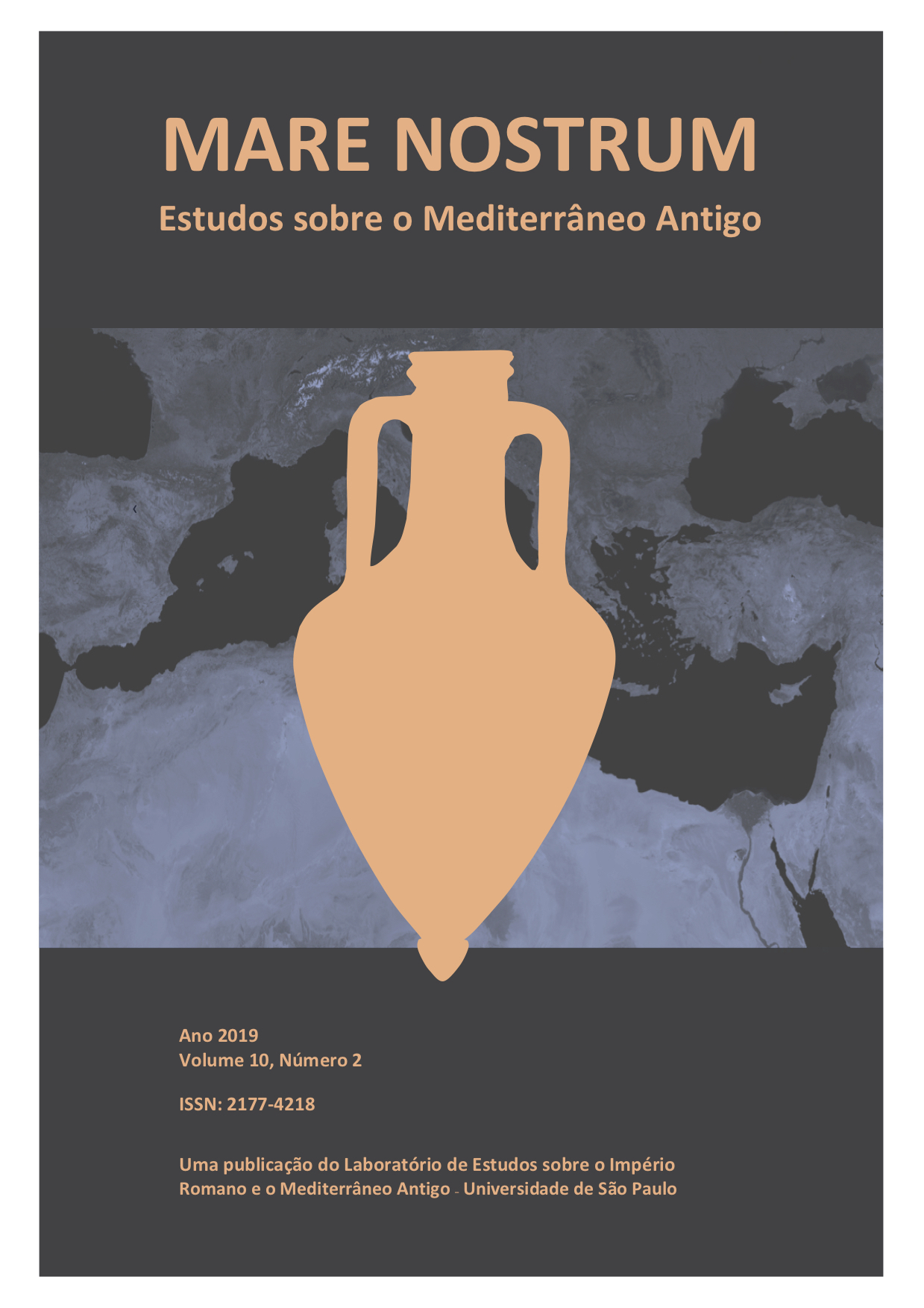Social Convulsions in Ancient Egypt: the workers of Theban necropolis in the end of the new kingdom
The Workers of Theban Necropolis in the end of the New Kingdom
DOI:
https://doi.org/10.11606/issn.2177-4218.v10i2p1-23Keywords:
Ancient Egypt, New Kingdom, Ramesside Period, Deir el-Medina, ThebasAbstract
The period of the New Kingdom of Ancient Egypt was finished in a context of social convulsions, which mined the pharaonic authority, contributing to the division between Upper and Lower Egypt. At the same time that was watched the increasing of the weight of the temples in the economy, especially the Domain of Amun, can be verified the weakening of the pharaonic power. In this framework, with an economic crisis installed, the workers of the Theban Necropolis started to rebel and, as a form of claim, they stopped working, in that what became registered as the first strike in the History, succeeded by many others. After they had faced thieves of tombs, attacks from Libyan gangs and a civil war, these workers left the Deir el-Medina village and they became integrated to the pillage industry of the royal tombs, which was installed in Thebes by the end of the 20th Dynasty. It represented a new factor of dynamism to that economy.
Downloads
References
ANTOINE, Jean-Christophe. “The Delay of the Grain Ration and its Social Consequences at Deir el-Medîna in the Twentieth Dynasty: A Statistical Analysis”. In: The Journal of Egyptian Archaeology, volume 95. London: The Egyptian Exploration Society, 2009.
BARWIK, Miroslaw. The Twilight of Ramesside Egypt: studies on the History of the Ramesside Period. Warsaw: Agade, 2011.
BLEIBERG, Edward. The economy of ancient Egypt. In: SASSON, Jack (org.). Civilizations of the Ancient Near East, vol. 3. New York: Charles Scribner's Sons, 1995.
BREASTED, James. Ancient Records of Egypt, vol. 4. Chicago: The University Press, 1906.
CARDOSOS, Ciro. Considerações Funcionais acerca das Cidades Egípcias do Reino Novo (XVIIIa - XXa Dinastias). Revista Phoînix. Vol. 2, 1996, 71-82.
ČERNÝ, J. A community of workmen in Thebes in Ramessid Period. Cairo: Bibl. D’Étude, 1973.
CLINE, Eric & O’CONNOR, David. Ramesses III – The life and times of Egypt’s last hero. Michigan: The Univesity of Michigan Press, 2015.
COLE, Edward. Decline in Ancient Egypt? A reassessment of the Late New Kingdom and Third Intermediate Period. PhD Thesis. University of Birminghan, 2016.
COONEY, Kathlyn. “Profit or Exploitation? The Production of Private Ramesside Tombs within the West Theban Funerary Economy”. In: Journal of Egyptian History, 1, Brill: 2008, pp. 79-115.
DJIK, Jacobus. “The Amarna Period and the Later New Kingdom”. In: SHAWN, Ian (ORG.). The Oxford History of Ancient Egypt. New York: Oxford University Press, 2000.
DONNELY, Debborah. Archaeological and Geographical Evidence for the Voyage of Wenamun. MA: 2004.
EYRE, Christopher. Work and the organization of work in the New Kingdom. In: POWELL, M. (Ed.). Labor in the ancient Near East, Vol. 68. New Haven: American Oriental Society, 1987, pp. 167-221.
FRANK, André & GILLS, Barry. The World-System: five-hundred year or five thousands?. London & New York: Routhledge, 1996.
GARCIA, Juan Carlos. “Temples and agricultural labour in Egypt, from the Late New Kingdom to the Saite Period”. In: GARCIA, Juan Carlos (org.). Dynamics of Production in the Ancient Near East (1300–500 BC). Oxford: Oxbow, 2016.
GARDNER, Alan. Ramesside Administrative Documents. London: Oxford University Press, 1948.
GRANDET, Pierre. Ramses III: historie d’un règne. Paris: Pygmalion, 1993.
GRANDET, Pierre. “Les grèves de Deîr el-Médînéh”. In: Les régulations sociales dans l'Antiquité. Rennes: Presses universitaires de Rennes, 2006.
GRANDET, Pierre. "Early to Mid-20th Dynasty". In Grajetzki, Wolfram, Wendrich, Willeke (Org.). UCLA Encyclopedia of Egyptology. Los Angeles: University of California Press, 2014.
GRIMAL, Nicolas, A History of Ancient Egypt. London: Blackwell Books, 1993.
HARING, Ben. “Ramesside Temples and the Economic Interests of the State”. In: Das Heilige und die Ware Zum Spannungsfeld von Religion und Ökonomie, vol. 7, Berlin: IBAES, 2007.
HARING, Ben. Deir el-Medina. In: REDFORD, Donald (org.). The Oxford Encyclopedia of Ancient Egypt. Oxford: Oxford University Press, 2001.
HENRY, John. The Social Origins of Money: the case of Ancient Egypt. Disponível em: <http://www.csus.edu/indiv/h/henryjf/pdfs/egypt.pdf>. Sacramento: 2002.
JANSSEN, Jan. Commodity Prices from Ramessid Period. Leiden: E. J. Brill, 1975.
KATARY, Saly. Land and tenure in the Ramessid period. London and New York: Kegan Paul International, 1989.
KEMP, Barry. Ancient Egypt: Anatomy of a Civilization. 2 ed., Taylor & Francis Routledge, 2006.
LULL, José. “El Reino Nuevo II: la Época Ramésida”. In: ORTIZ, José (Org.). El Antiguo Egipto: Sociedad, Economía y Política. Madrid: Marcial Pons, 2008.
MANDEVILLE, Richard. Wage accounting in Deir Al-Medina. Wallasey: Abercromby Press, 2014.
MARX, Karl. Contribuição à Crítica da Economia Política. 2a Edição. São Paulo: Expressão Popular, 2008.
MCDOWELL, A. G. Village Life in Ancient Egypt: Laundry Lists and Love Songs. Oxford: Oxford University Press, 1999.
MESKELL, Lynn. “An Archaeology of Social Relations in an Egyptian Village”. Journal of Archaeological Method and Theory, Vol. 5, No. 3. Oxford: 1998.
MLADJOV, Ian. “The Transition between the Twentieth and Twenty-First Dynasties Revisited”. Birmingham Egyptology Journal, 5, 2017, pp. 1-23.
MORRIS, Ellen. The architecture of imperialism: military bases and the evolution of foreign policy in Egypt’s New Kingdom. Leiden & Boston: Brill, 2005.
PEDEN, Alexander. The Reign of Ramesses IV. Liverpool: Aris & Phillips Ltd, 1994.
PEDEN, Alexander. The Graffiti of Pharaonic Egypt. Leiden: Brill, 2001.
PEET, T. The Great Tomb Robberies of the 20th Egyptian Dynasty. New York: Hildesheim, 1997.
SHAWN, Ian. The Oxford History of Ancient Egypt. New York: Oxford University Press, 2000.
TOLEDO STELLA, Thomas. “Cosmogonias e Demiurgos: Diversidade Religiosa no Antigo Egito e sua Relação com o Poder Faraônico”. Anais III Encontro do GT História Antiga e Medieval ANPUH-SC. UFSC, 2018. Disponível: <https://gtantigamedievalsc.wixsite.com/iiiencontro>. Acesso: 14/3/2019.
TOLEDO STELLA, Thomas. “O Domínio de Amon : a importância de Ipetsut (Karnak) na economia egípcia do Reino Novo”. In: BRANCAGLION JR., Antônio & CHAPOT, Gisela (Org.), Semna: Estudos de Egiptologia, Volume 5, Rio de Janeiro: Editora Klíne, 2018.
VERNUS, Pascal. Affairs and Scandals in Ancient Egypt. Ithaca and London: Cornell University Press, 2003.
WARBURTON, David. “Before the IMF: the economic implications of unintentional structural adjustment in Ancient Egypt”. Journal of the Economic and Social History of the Orient. Vol. 43, No. 2, Leiden: Brill, 2000, pp. 65-131.
WARBURTON, David. “The Egyptian Example and the Macroeconomic Implications”. In: PERMA, Massimo (org.). Fiscality in Mycenean and Near Eastern Archieves. Paris: 2006.
WARBURTON, David. “What might the Bronze Age World-System Look-Like?”. In: WILKINSON, Toby, SHERRATT, Susan & BENNETT, John (Orgs.). Interweaving the World: Systemic Interactions in Eurasia, 7th to 1st Millennia BC. Oxford: Oxbow, 2011.
WATTS, Edith. Art of Ancient Egypt. New York: The Metropolitan Museum, 1998.
WILKINSON, Toby. The Rise and Fall of Ancient Egypt. London: Bloomsbery, 2010.
ZINGARELLI, Andrea. “Tebas durante el período Ramésida: redistribución y circulación de bienes”. Revista Mundo Antigo. Ano IV, V. 4, N° 07. Rio de Janeiro: 2015.
ZINGARELLI, Andrea. “Huelgas de trabajadores en el Imperio Nuevo egipcio”. In: ASTARITA, Carlos, McGAW, Carlos y ZINGARELLI, Andrea (Orgs.). Confictos sociales en la Antigüedad y el Feudalismo. La Plata: Editorial de la Universidad de La Plata. 2017A.
ZINGARELLI, Andrea. “Contradicciones sociales a fines del Imperio Nuevo egipcio: los robos de bienes”. In: ASTARITA, Carlos, McGAW, Carlos y ZINGARELLI, Andrea (Orgs.). Confictos sociales en la Antigüedad y el Feudalismo. La Plata: Editorial de la Universidad de La Plata. 2017B.
Downloads
Published
Issue
Section
License
Copyright (c) 2019 Thomas Henrique de Toledo Stella

This work is licensed under a Creative Commons Attribution 4.0 International License.
Responsibility for the content published by Mare Nostrum rests exclusively with the author(s) of such content.
The reproduction of the texts published by Mare Nostrum is licensed according to Creative Commons license Attribution-NonCommercial 4.0 International (CC BY-NC).
Authors who publish with this journal agree to the following terms:
- Authors retain copyright and grant the journal right of first publication with the work simultaneously licensed under a Creative Commons Attribution License that allows others to share the work with an acknowledgement of the work's authorship and initial publication in this journal.
- Authors are able to enter into separate, additional contractual arrangements for the non-exclusive distribution of the journal's published version of the work (e.g., post it to an institutional repository or publish it in a book), with an acknowledgement of its initial publication in this journal.
- Authors are permitted and encouraged to post their work online (e.g., in institutional repositories or on their website) prior to and during the submission process, as it can lead to productive exchanges, as well as earlier and greater citation of published work (See The Effect of Open Access).









